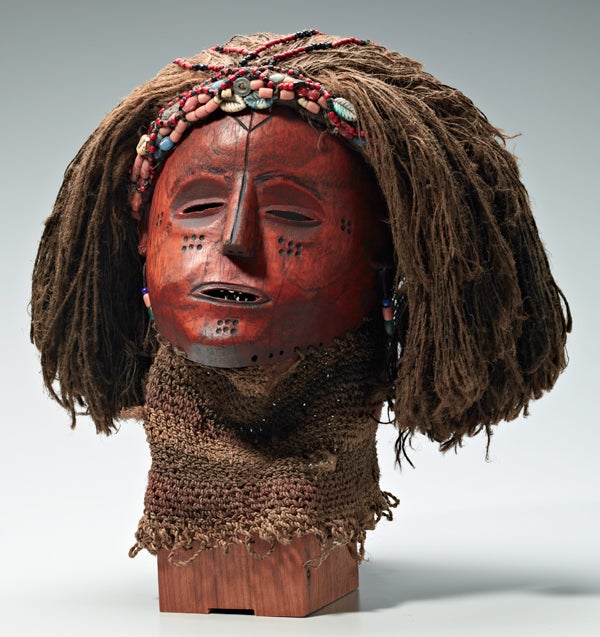|
View slideshow here.
August 4, 2011
Stanford's Cantor Arts Center spotlights six millennia of African art
Cantor has renovated its African galleries – and the result is a lavish and provocative look at an entire continent, from 4,000 B.C. to the present. As always in Silicon Valley, the galleries have a high-tech bent – colorful, comprehensive and cutting edge. By Cynthia Haven

This ca. 1980 Zambian face mask by an unknown artist is among the pieces included in the Cantor Arts Center exhibit. (Photo: Courtesy of Cantor Arts Center) In the summer of 1976, Kenyan-born artist Magdalene Odundo was visiting a cousin who was a mathematician at the SLAC National Accelerator Center.
Instead of having face time with a relative, however, she spent her days at the Cantor Arts Center, where she was transfixed by three small, pre-dynastic Egyptian burnished pots and "their power to mesmerize and amaze," as she recently wrote. "Their timelessness and beauty were astonishing, almost sacred."
Odundo, who had just completed her degree in ceramics in the United Kingdom, may have neglected her cousin that summer – but she shifted several thousand miles away from the British studio pottery movement she had previously studied.
The result of Odundo's about-face is on display at the Cantor Arts Center. The museum acquired her carbonized and multi-fired red clay vase, a modern take on ancient craftsmanship, in 2008. It's part of "Expanding Views of Africa," which opened Aug. 3.
The enlarged and enhanced African reinstallation includes about 200 works from Cantor's holdings (of about 2,000 objects in total) as well as new loans from an outstanding private collection. It represents more than 6,000 years of African history, from about 4,000 B.C. to modern times. The reinstallation will be a permanent exhibition at the Cantor Arts Center.
The renovated African galleries are a dizzying display of time and space: from the modern Tuareg jewelry of nomadic Saharan tribes to an Egyptian mummy mask from the sixth or seventh centuries B.C., from 19th-century Nguni beadwork to a ca. 1980 Zambian face mask, made with fiber, beads and plastic leaves by an unknown artist.
"In many ways we're breaking ground," said Barbara Thompson, curator of the arts of Africa and the Americas. For example, "we're collecting contemporary arts – very few museums are collecting contemporary arts from Africa."
In addition, while many museums focus on West and Central Africa, the Cantor collection includes underrepresented regions of Africa – for example, she said, "the great civilizations and cultures south of the Sahara."
"Every region is marked by its own school of thought and direction," Thompson said.
Moreover, while Egyptian art is often grouped with Greece and Rome, Cantor's exhibition brings Egypt back definitively to the African continent.
Some regular Cantor visitors will recognize old friends, retrieved from storage: "Many of the objects have been 'on vacation' for two to three years," said Thompson.
She also noted that some of the Egyptian pieces, collected by Jane Stanford, have been "sitting in safes since the 1880s."
In the heart of Silicon Valley, "something old, something new" inevitably has a high-tech edge. The reinstallation features electronic touch screens and descriptive labels that, with a quick photo from a smartphone, link to relevant interviews, scholarship, YouTube videos and African music.
Cantor Director Thomas Seligman, who will continue his research on African art and culture after he steps down at the end of the year, said the lavish and colorful reinstallation underscores the Bay Area's presence in African art and culture, thanks to a small cadre of avant-garde collectors and scholars. He ought to know: Seligman was the first curator of African art at San Francisco's De Young Museum in 1971.
Cantor's African collection is among the finest at any university museum in the country, he said, thanks in part to a joint program in African studies Stanford shares with the University of California-Berkeley.
Seligman praised "both the scholarship and comprehensiveness" of Thompson's work. "What Barbara has done is cutting edge – not the first blade, but on the cutting edge."
For Kenyan artist Odundo, it provided a chance to be part of the museum that mesmerized her more than 30 years ago. As she herself wrote, "Destiny sometimes defies explanation."
Admission is free. The Cantor Arts Center is open Wednesday through Sunday from 11 a.m. to 5 p.m., Thursday to 8 p.m. For museum information, call (650) 723-4177.
-30-
|